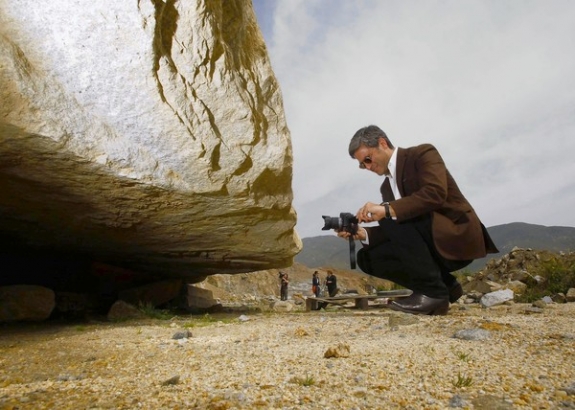Michael Govan, the director of the Los Angeles County Museum of Art, crouched in the pit of a stone quarry in Riverside. Wearing black jeans and a brown sports coat, he dragged a finger through the sandy floor to draw the northern edge of the LACMA campus.
On a key spot in his ad-hoc map, he placed a granite stone the size of an orange, meant to represent a rugged 340-ton boulder standing in the quarry behind him. If all goes according to plan, that boulder will make a seven-day journey in August from the quarry to the museum on a specially designed 200-wheel truck. There, it will rest on two concrete rails lining a 15-foot-deep trough, as the museum's newest sculpture: "Levitated Mass" by Michael Heizer, a famously reclusive artist who has devoted decades to building a "city" of earthworks in the Nevada desert that few outsiders are allowed to visit.
LACMA's director describes the boulder, which visitors will be able to walk under as though it were levitating — as simultaneously contemporary and timeless. "It's ultramodern because it's self-referential and it's about the viewer's experience — it doesn't represent some god," he says. "Yet it has the timeless, ancient overtones of cultures that moved monoliths, like the Egyptians, Syrians and Olmecs."
To hear Govan talk so passionately about this artwork, which is after all one big rock, is to get some sense of what makes him a powerful advocate for artists, an effective fundraiser and an increasingly influential cultural leader in Los Angeles.
"He is a great communicator who makes his ideas and vision for the museum almost infectious," says Ari Wiseman, deputy director of the Guggenheim in New York, who used to hold a similar museum post in L.A.
"I think Michael is to LACMA what Dudamel is to the Philharmonic and Placido Domingo is to the Opera," says Zev Yaroslavsky, the L.A. County supervisor for the district that includes LACMA. "He might not have that kind of celebrity, but he has the same ability to move and inspire people, even people who don't think they're interested in art." Yaroslavsky counts himself among the converts, saying he's become "a nut for these big outdoor pieces of art" under Govan's influence.
Five years into his stewardship of LACMA, having just signed a contract for five more, Govan, 47, has transformed the museum and its reputation. He has overseen the completion of two sleek new exhibition halls by renowned Italian architect Renzo Piano, grown the collection by about 12,000 objects and helped boost annual attendance by some 40%.
But LACMA also has transformed Govan. When he arrived at LACMA, some viewed him rather reductively as an empire builder: the ambitious, fast-talking protege of his onetime boss Thomas Krens, the controversial Guggenheim Museum director known for trying to go global by opening branches around the world. But by now it's clear that Govan's vision for LACMA is not just to make it bigger and better a la Krens.
It's a museum offering a little something for everyone: art from many centuries inside the galleries and a mix of architectural styles and large-scale artworks like the Heizer outdoors. He has made a point of partnering with other nonprofits in the L.A. film community, art world and beyond, and sees LACMA as an anchor — geographically and also intellectually — for the region's growing cultural community. These days, he is constructing alliances as well as buildings.
"LACMA by its nature could be a great collaborator. We're in the middle of things, we're multidisciplinary, we're multicultural, we're a general art museum," Govan says, "so by definition we can encompass almost everything culturally."
Govan is a "visionary" with a difference, says the artist Jeff Koons, describing realpolitik skills that help the museum leader adapt to economic necessity. "He bridges the impractical and the practical — bringing these vast or grand gestures into the world through his understanding of institutions and the support of businesspeople."
Those skills also are evident in Govan's ability to bounce back from adversity. In what surely ranks as Govan's single biggest setback to date, LACMA's most generous and powerful donor, art patron and philanthropist Eli Broad, announced in 2008 that he would not, after funding a building in his name at LACMA, bequeath his billion-dollar art collection to the museum. Later that year, Broad rode to the rescue of the near-bankrupt downtown Museum of Contemporary Art with a $30-million pledge. Broad's dramatic gesture helped quash a proposal to merge MOCA into Govan's museum.



